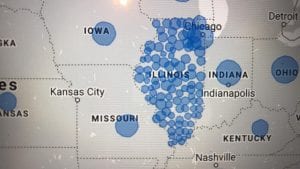BREAKING: Quad-Cities Could Hit “100 Percent” Covid Infection At Current Rates, According To New Data
BREAKING NEWS: Every person in the Quad-Cities and surrounding communities could end up infected with covid-19 if cases continue at current rates through the fall of 2021, according to latest statistics from the Illinois Department of Health and Covid Act Now, a not-for-profit national data aggregation website affiliated with the medical departments of Stanford, Harvard and Georgetown Universities.
“On average, each person in Rock Island County, Illinois with COVID is infecting 1.17 other people. As such, the total number of active cases in Rock Island County, Illinois is growing at an unsustainable rate. If this trend continues, the hospital system may become overloaded. Caution is warranted,” the site posted Saturday. “A relatively high percentage (20.2%) of COVID tests were positive, which indicates that testing in Rock Island County, Illinois is limited and that most cases likely go undetected. At these levels, it is hard to know how fast COVID is actually spreading, and there is very high risk of being surprised by a wave of disease. More testing urgently needed.”
The Illinois and Iowa Quad-Cities covid-19 cases are spiking to new daily heights, following worsening numbers throughout both states, according to the latest data by the Illinois and Iowa Departments of Health.
Rock Island County remains in the critical level according to the latest statistics from Covid Act Now. Over the last week, Rock Island County, Illinois has averaged 170 new confirmed cases per day (119.9 for every 100,000 residents). Over the next year, this translates to around 62,000 cases and an estimated 310,000 infections (100.0% of the population), according to Covid Act Now.
 IDH posted 11,891 new confirmed and probable COVID-19 cases and 127 additional deaths Saturday. That was a slight dip after the state had hit new records for cases and deaths on Thursday and Friday.
IDH posted 11,891 new confirmed and probable COVID-19 cases and 127 additional deaths Saturday. That was a slight dip after the state had hit new records for cases and deaths on Thursday and Friday.
The state moved back into more strict coronavirus restrictions Friday, entering Tier 3 mitigation levels designed to slow the spread of COVID-19.
With covid-19 cases spiking throughout the state, Illinois Governor JB Pritzker announced the new restrictions on Tuesday, mentioning not just the rapid spread in terms of covid infections but their impact upon hospitals and people who may need the hospitals for other health emergencies.
“We’re trying to look ahead weeks so we don’t end up in a situation where hospital beds are over 100 percent filled by Christmas,” Pritzker said during his press conference Friday. “Remember there are a lot of people who come to hospitals for non-covid-related medical needs, and we don’t want to get to the point where all the beds are full because of the spread of covid. If we continue at the pace we’re going, without any mitigation, that’s what’s going to happen.”
On his Twitter account following the press conference, Pritzker posted: “I know that this virus is taking its toll in many ways. We all want this to be over – but hope is on the horizon. We just have to keep going so that when we get to the other side of this pandemic, we will have done everything we can to get everyone there safely.”

Covid is now the third-leading cause of death in the state, according to today’s data.
Covid-19 is now the third-highest cause of death in Illinois, according to statistics announced Thursday, one day before additional statewide coronavirus mitigations were slated to go into effect.
As businesses and workers gird themselves for financial hardships the federal government and both political parties have ignored in lieu of political games over a stimulus, businesses are being stretched to the breaking point and Illinois was hit with its highest single-day death count since mid-May, suffering 168 new coronavirus-related fatalities, according to the Illinois Department of Public Health.
Sweeping restrictions are in effect as of Friday.
According to the Restore Illinois Mitigation Plan, the new mitigation requirements to combat the surge of COVID-19 across Illinois are as follows:
- Operate at no more than 25% capacity, including general merchandise stores, “big box” stores that offer groceries and pharmacy, and convenience stores
- Grocery stores and pharmacies may operate at up to 50% capacity
- Encourage delivery or curbside pickup options wherever possible
- When in-store shopping is necessary, promote efficient trips and consistent circulation
- Operate at lesser of 25 clients or 25% capacity
- Face coverings must be worn at all times by clients and service providers
- Suspend services where a face covering cannot be worn (e.g. facials, beard trims)
- Physical, occupational and massage therapy allowed as deemed necessary by a medical provider, but appointments must be spaced by a minimum of 15 minutes and facilities should take steps to sanitize and circulate clean air through service rooms before and after each service
- Virtual consultations recommended
- Operate at no more than 25% capacity
- No indoor group classes
- Face coverings must be worn at all times, including while engaged in individual exercise regardless of person or machine spacing
- Reservations required
- Locker room areas should be closed
 Hotels
Hotels- Hotel room occupancy should be limited to registered guests only, with the maximum allowance being the number of individuals permissible per existing fire code for each applicable guest room
- Fitness centers should be closed, or operated only on a reservation model, with capacity limited to 25% of the maximum occupancy for the room.
- Grab and go food allowed
- Event and meeting space closed
- Additional COVID training for all employees required even if previous training occurred
- Operators should coordinate with IDPH to implement testing protocols and contact tracing, upon request, consistent with available testing supplies
- All employees must wear face coverings at all times unless eating or drinking. Exemptions only for safety purposes.
- Only manufacturing staff and key personnel allowed in facilities. Non-production employees must work remotely. Non-essential staff and visitors are not permitted. Exemptions only for critical equipment repairs, supply deliveries and safety reasons (“critical visitors”).
- All critical visitors must have an Employee Health and Safety (EHS)-approved risk-assessment done in advance, including travel history, tracking, and temperature check prior to entrance.
- Implement additional workstation realignment when feasible
- Stagger and space shifts, and designate shift entrances and exits (when possible) to minimize interactions of employees across unique shift groupings
- Station sanitation required at beginning and ending of shifts
- Operators must suspend covid-related incentive pay and promote staying home when sick or showing symptoms
- Implement temporary leave policies to accommodate workers who are sick
- Develop and implement safety protocols for employee travel vans to promote spacing, require face coverings, temperature checks, air circulation, and vehicle sanitization
-

Illinois Gov. JB Pritzker.
Bars and Restaurants
- All bars and restaurants close at 11pm and may reopen no earlier than 6am the following day
- No indoor service
- All bar and restaurant patrons should be seated at tables outside
- No ordering, seating, or congregating at bar (bar stools should be removed)
- Tables should be 6 feet apart
- No standing or congregating outdoors while waiting for a table or exiting
- No dancing or standing indoors
- No tables exceeding 6 people
- Reservations required for each party
- No seating of multiple parties at one table
- Indoor gaming terminals must suspend operations
- Includes private clubs and country clubs
- Limit in home gatherings to household members
- Meeting rooms, banquet centers, private party rooms, private clubs and country clubs may not host gatherings
- No party buses
- Funerals are limited to 10 family members of the decedents, not including staff, see IDPH guidance
- All employees who can work remotely should work remotely
- Pause all indoor group sporting and recreational activities including youth and adult recreational sports, individual training may remain (with facility reservation)
- Includes park districts and travel leagues
- Outdoor sports and recreation allowed
- Participant groups and practices outdoors limited to 10 persons or less with social distancing
- Face coverings required for all activities at all times
- Locker rooms should be closed
- Gaming and casinos close
- Indoor recreation centers, including theaters, performing arts centers and indoor museums and amusement centers close
- Live streaming of performances encouraged with social distancing of performers and minimum operational staff
- Outdoor activities allowed at 25% capacity or less
- Outdoor group activities limited to 10 persons or less, participants/guests must wear face coverings at all times
- Reservations required for each guest for outdoor activities
The provisions above apply to industries/sectors with Restore Illinois Phase 4 guidance or other mitigations. Other functions (i.e. infrastructure, governments, logistics and warehousing etc.) that previously have not been subject to specific guidance may continue regular operations but are encouraged to voluntarily take proactive steps to support new mitigation strategy wherever possible. In these areas, customer serving functions should be limited to 25 percent capacity, aligned with Retail mitigations, and maximize work from home wherever possible.










